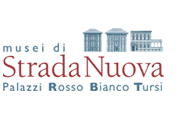The Depositories: a second gallery
Palazzo Bianco and its depositories
A “secondary gallery” made of 18 rooms with more than 200 paintings not to be missed.
Palazzo Bianco was conceived starting from the last decades of the XIX centuries as a civic museum of art and history and it went through consecutive and different settings of its important and complex civic heritage.
The current layout, which more marked the Museum history, dates back to the post-war period, when the gallery was reopened in 1950 with a new organization conceived by Caterina Marcenaro (1906-1976), new director of the Fine Arts Department, and a set up designed by Franco Albini (1905-1977), architect of rationalist background.
A high profile result, based on a rigorous selection of the displayed works and on original museographic choices, upset the most conservative expectations and put the attention of the world of culture, at national and international level, on the renovated museum.
The setting was caracterized by an extreem formal precision, that shined through the light gray colour of the walls and vaults, from the uniform flooring, the skillful use of the lighting and finally from the supports, realized with poor industrial, black painted materials.
The innovative modernity in conceiving and setting up the depositories caused a sensation; they were made not to hide art pieces, but rather to preserve them and made them visible to experts, tourists and art enthusiasts.
Palazzo Bianco has a wide area, dedicated to the depositories, large as much as a floor of the building, that is situated on the fourth level of the Museum.
The paintings are presented with the same criteria as in the Gallery, obviously in a tighter arrangement, with bulkheads in the middle of the halls, on which works are displayed in order to optimise the space.
It was conceived to be visited, to serve as seconary gallery and to stand in as a “reserve” where to gain for changing and increasing the main exposition path, or for presenting paintings awaiting restoration or currently being the subject of research.
A rich depository is an invaluable asset to a museum, as it provides the opportunity to change and reinvent itself.
More than 200 paintings, displayed in 18 halls, are at visitors’ disposal.
The overview of Genoese painting between 16-18th century is very broad, followed by a section on Italian artists and one devoted to Flemish, Dutch, and French painters.
The exhibition begins with the paintings by Genoese masters of the 16th century (Luca Cambiaso, Cesare Corte), early 17th century (Bernardo Castello, Giovan Battista Paggi, Simone Barabino, Strozzi, Giovanni Andrea De Ferrari, Domenico Fiasella, Anton Maria Vassallo and Luciano Borzone), and late 17th century (Valerio Castello, Stefano Magnasco) ; there is also a large number of paintings and reproductions of masterpieces created by “Casa Piola”, with works by Domenico, Anton Maria and Paolo Gerolamo, including a series of sketches for fresco decorations by the latter. The section ends with the paintings by Raffaele Badaracco, Gregorio De Ferrari, as well as the 18th-century portraits (Domenico Parodi and Mulinaretto), and landscapes of Genoese origin from the same time period.
Finally, the depositories exhibit 16th-17th-century paintings by Italian artists, as well as Flemish and Dutch masters between 16th and 18th century, such as Van Deynen, Wildens, De Wael, Daniel van den Dijck, Joos de Momper, Malò and Tempesta.




